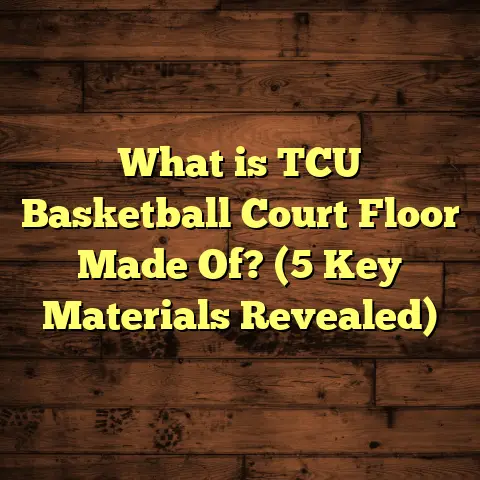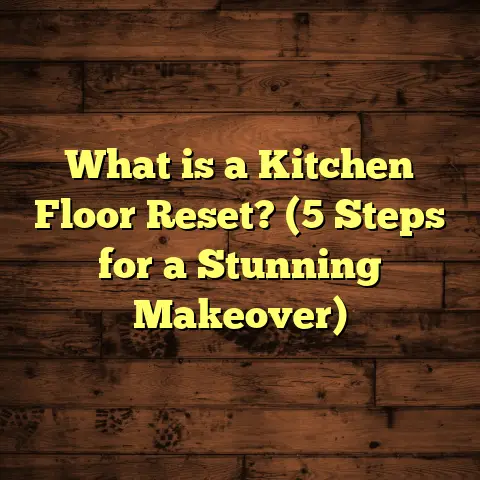What is a Camper Subfloor? (5 Key Benefits Explained!)
Have you ever paused to think about what’s beneath your camper’s floor? Most people don’t. They focus on the cozy finishes, the comfy carpet, the stylish vinyl, or the warm hardwood. But beneath those layers lies something that can make or break your whole camper experience—the subfloor. I remember the first time I got called out to fix a camper floor that was creaking each time someone stepped in one spot. At first, I thought it was just a loose board. But when I lifted the floor, I realized the subfloor was completely rotted and compromised. That day stuck with me because it showed just how important this hidden layer really is.
If you’re into campers or RV living, understanding what a camper subfloor is and why it matters will save you time, money, and headaches. Let me walk you through everything I’ve learned over years of renovating, repairing, and building camper floors—from what a subfloor actually is, to the key benefits it provides, to practical tips on materials, installation, and budgeting.
What Is a Camper Subfloor?
At its core, a camper subfloor is the structural base layer beneath your finished flooring inside an RV or camper trailer. It’s the platform that supports whatever flooring you choose—carpet, laminate, vinyl planks, or hardwood boards. Just like in a house, the subfloor is vital because it spreads weight evenly and provides a stable surface.
But here’s where campers differ from traditional homes: they move. Every bump in the road causes vibrations and flexing. Campers also face moisture from outdoor conditions and condensation inside. So their subfloors need to be specially designed to be lightweight yet strong and resistant to moisture.
Most camper subfloors are made from plywood or composite boards treated to resist water damage. This helps prevent rot, warping, and mold growth over time. They usually range between ½ inch and ¾ inch thick depending on the camper’s design and weight considerations.
When I first got into camper renovations, I underestimated how much of a difference a solid subfloor could make. One old camper I worked on had an uneven floor that made walking inside feel like a roller coaster—it was uncomfortable and unsafe. After replacing the subfloor with marine-grade plywood and sealing everything thoroughly, the floor became rock solid. The transformation was amazing.
Why Does Your Camper Need a Quality Subfloor?
Before we jump into the benefits, let’s talk about why this hidden layer is so critical. Campers face unique challenges compared to houses:
- Constant movement causes stress on flooring materials.
- Exposure to moisture can cause rapid deterioration.
- Weight limits mean materials must be strong but light.
- Temperature swings impact insulation needs.
- Limited space demands precision in installation.
A camper subfloor addresses these challenges by providing strength, protection, comfort, and longevity to your flooring system. Without it, even the best flooring materials won’t last long or perform well.
I’ve seen too many campers where cheap or damaged subfloors led to sagging floors, water damage, or squeaky joints. Fixing those problems after installation is costly and frustrating.
5 Key Benefits of a Camper Subfloor
Let me break down five major benefits of having a properly constructed camper subfloor based on my hands-on experience and research.
1. Provides Stability and Structural Support
The first job of any subfloor is to give your flooring materials a sturdy base to rest on. This means reducing flexing and movement when you step inside.
Campers are compact spaces where weight distribution changes as people move around or add furniture like tables and beds. A rigid subfloor spreads that load evenly over the frame underneath.
In one renovation project, I swapped out a thin plywood subfloor that had started sagging under heavy appliances for a thicker marine-grade plywood board. The difference was immediate—no more bouncing floors or creaking sounds.
Data point: According to industry standards, a ¾-inch plywood subfloor can support over 40 pounds per square foot without noticeable deflection—enough for heavy furniture and daily use in campers.
2. Protects Against Moisture Damage
Moisture is one of the biggest enemies of camper floors. Water leaks from windows, condensation buildup inside, or spills can all seep into untreated subfloors causing rot and mold.
That’s why most quality camper subfloors are made with water-resistant or marine-grade plywood treated with preservatives or sealed with waterproof coatings.
I once worked on an older camper where water had gotten under the floor near plumbing lines. Because the subfloor was untreated standard plywood, it absorbed water quickly and started rotting within months. The owners had no idea until the floor started sagging dangerously.
Using moisture-resistant materials prevents this nightmare scenario.
Stat: Studies show marine-grade plywood can resist moisture absorption up to 30% better than standard plywood, dramatically extending lifespan in damp environments.
3. Improves Insulation and Energy Efficiency
Not many people think about insulation under their camper’s floor, but it can make a huge difference in comfort levels.
Some builders add insulated foam panels beneath or within the subfloor to reduce heat loss in winter and keep interiors cool in summer.
During one build, I installed rigid foam insulation under the plywood subfloor which cut down drafts significantly. The camper stayed warmer during cold nights without using extra power on heating.
This also reduces condensation under the floor which helps prevent moisture problems long-term.
Insight: Adding even just half an inch of foam insulation can improve thermal resistance (R-value) by roughly R-2 to R-3 depending on material used.
4. Reduces Noise and Vibration
If you’ve ever taken a long trip in a camper where every bump sounds like thunder beneath your feet, you know how annoying road noise can be.
A well-built subfloor acts as a buffer absorbing some vibrations before they travel up through your feet and flooring materials.
Early in my career, I had a client complain about rattling noises as they drove over rough terrain. Upgrading their subfloor thickness from ½ inch to ¾ inch plywood combined with sound-damping mats made a noticeable difference in ride comfort.
5. Simplifies Installation and Future Repairs
Finally, having an even, strong subfloor makes installing new flooring materials much easier and ensures better results.
If your subfloor is uneven or damaged, laying laminate or vinyl planks becomes a nightmare with gaps and bumps appearing quickly.
From my experience, investing time in proper subfloor preparation before installing finishes saves hours later fixing mistakes or dealing with squeaks.
Also, when repairs are needed down the road—maybe due to plumbing leaks or damage—the subfloor can often be accessed and replaced independently without demolishing the entire floor system.
Exploring Materials: What Makes a Good Camper Subfloor?
When you start looking at options for building or replacing a camper subfloor, material choice matters big time. Here’s what I’ve learned after years of testing different types:
Marine-Grade Plywood
This stuff is my favorite for wet areas like bathrooms or kitchens inside campers. It’s made with waterproof glue and high-quality veneers that resist swelling and rot.
It’s heavier than regular plywood but worth it if you want longevity.
Standard Plywood with Sealant
If budget is tight, using good-quality plywood combined with waterproof sealants or epoxy coatings can work well enough for dry areas. But you must be diligent sealing edges and seams to prevent water intrusion.
Composite Panels
Composite panels made from wood fibers mixed with resins offer excellent moisture resistance and lightweight properties. They are becoming popular for high-end builds but cost more upfront.
Thickness Recommendations
I usually recommend ¾-inch thickness for most campers because it balances strength with weight well. Thinner panels can flex too much especially under heavy furniture or appliances.
How I Use FloorTally for Cost Estimates
Estimating costs accurately has always been tricky for me until I started using FloorTally—a tool that pulls local labor rates and material prices together for realistic budgeting.
For example, when planning a full floor replacement on a 200-square-foot camper interior:
- FloorTally helped me calculate material costs including marine-grade plywood plus sealants.
- It factored in labor charges based on local averages.
- It added waste percentages so I ordered enough extra material.
- The tool gave me a clear total estimate within minutes rather than waiting days for multiple quotes.
This level of visibility lets me plan projects confidently without surprises halfway through work. I appreciate how easy it is to customize inputs like panel thickness or types of finish flooring too.
Some Personal Stories from Camper Floor Jobs
I want to share two contrasting experiences from my projects that highlight why getting your subfloor right matters:
Story 1: The Neglected Subfloor Disaster
A client bought an older camper cheap because it looked clean inside. But after just one heavy rainstorm during a trip, their floor started sagging alarmingly in spots. Moisture had rotted the untreated plywood subfloor beneath the vinyl planks they’d installed themselves.
Fixing it involved ripping out all flooring materials, removing the rotten wood layers, treating underlying frame members for mold, then replacing with marine-grade plywood sealed carefully at edges.
This job took double the time and money original because they had skipped inspecting the subfloor initially.
Story 2: The Thoughtful Build That Lasts
Another client wanted a custom off-grid camper built from scratch. We used composite panels for the subfloor with an insulated foam layer underneath sealed with waterproof membranes.
Three years later during maintenance checks, everything remained perfectly dry with no signs of wear despite frequent off-road use in wet climates.
The floors felt solid and quiet on bumpy roads thanks to thicker materials and sound-damping treatments.
When Should You Replace Your Camper Subfloor?
Good question! Not every camper needs a new subfloor immediately but watch for these warning signs:
- Floors feel soft or spongy when stepping.
- Visible water stains or mold underneath flooring.
- Persistent creaking sounds.
- Noticeable sagging or uneven spots.
- Flooring materials lifting or buckling without obvious cause.
If you spot any of these issues, it’s time to inspect your subfloor closely—often by lifting small sections of flooring if possible—and consider replacement.
How to Inspect Your Camper Subfloor Like a Pro
You don’t need fancy tools for basic inspection:
- Look for discoloration under removable flooring sections.
- Use a screwdriver or awl to gently prod suspicious areas—softness means decay.
- Check around plumbing lines for leaks.
- Smell for musty odors indicating mold.
- Inspect edge seals near doors or windows where water might enter.
Taking these steps early can save big repair bills later.
DIY vs Professional Installation: What Should You Do?
If you’re handy with tools and have experience working on campers or boats, installing your own subfloor can be rewarding (and cheaper).
But if your camper has complex framing or you’re unsure about moisture control measures like sealing edges properly—hiring a pro might be wise.
I’ve done both myself—DIY jobs when confident; hired specialists when tight tolerances mattered most (like custom composite installations).
Whatever path you choose, don’t rush installation—precision matters!
FAQs About Camper Subfloors
Q: Can I install carpet directly over plywood as my camper’s final floor?
A: You can but make sure the plywood is smooth, sealed against moisture, and structurally sound first. Otherwise carpet may trap moisture leading to mold underneath.
Q: How often should I check my camper’s subfloor?
A: Inspect at least once per year or after heavy storms/trips involving wet conditions to catch early issues.
Q: What’s better: OSB or plywood?
A: Plywood generally performs better in moisture-prone environments due to tighter grain structure but OSB is cheaper if sealed well.
Q: Will adding insulation under my subfloor increase camper height too much?
A: Usually foam panels add minimal thickness (around ½ inch) but check clearances especially around doors/steps before finalizing plans.
Wrapping Up My Thoughts on Camper Subfloors
The more campers I work on, the more convinced I am that ignoring the subfloor is like building a house on sand—pretty soon everything collapses or costs way more than expected fixing it later.
Whether you’re buying used, renovating an old rig, or building new from scratch—take time to understand your camper’s subfloor condition and choose materials wisely based on your climate, usage patterns, and budget.
Remember that stability, moisture resistance, insulation, noise reduction, and ease of repair all rely heavily on this hidden layer beneath your feet.
And if budgeting feels overwhelming at first? Use tools like FloorTally that have helped me plan projects smoothly by giving transparent cost breakdowns so you know exactly what to expect financially before picking up a saw or hammer.
Your camper deserves this kind of care because every trip should be about adventure—not worrying about what’s falling apart underfoot!
Got questions? Hit me up anytime—I’m always happy to share what I’ve learned through real-world experience. Safe travels!





